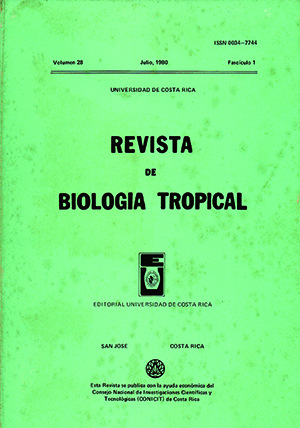Abstract
Fruiting almendro trees, Dipteryx panamensis, are visited by sixteen species of mammals that eat the fruits exocarp or seed. Seeds are susceptible to predation by granivorous rodents and peccaries. Most mammals that visit Dipteryx trees act as commensals·, eating only the fleshy exocarp and dropping the endocarp with its enclosed seed below the parent tree. So me primates, tayras, coatis, and kinkajous occasionally disperse Dipteryx seeds, but only Artibeus lituratus, Dasyprocta punctata, and Sciurus granatensis disperse large numbers of seeds. Whether D. punctata or S. granatensis act as seed predators or dispersal agents depends on the behavioral context in which they handle fruits.
References
Bonaccorso, F.J. 1979. Foraging and reproductive ecology of a community of bats in Panama. Bull. Fla. St. Mus., Biol. Sci., 24: 359-408.
Chapman, F. M. 1938. Life in an air castle. Appleton-Century, New York, 250 p.
Cruz, A. 1974. Feeding assemblages of Jamaican birds. Condor, 76: 103-107.
Diamond, J.M. 1973. Distributional ecology of New Guinea birds. Science, 179: 759-769.
Diamond, J.M., & J.W. Terborgh. 1967. Observations on bird distribution and feeding assemblages along the Rio Callaria, Department of Lorento, Peru. Wilson Bull., 79: 273-282.
Downhower, J.F., & C.H. Racine. 1976. Darwin's finches and Croton scouleri: an analysis of the consequences of seed predation. Biotropica, 8: 66-77.
Duke, J.A. 1967. Mammal Dietary. Battelle Laboratories (Mimeographed).
Eisenman, E. 1961. Favorite foods of neotropical birds: flying termites and Cecropia catkins. Auk, 78: 636-638.
Fleming, T.H., E.R. Heithaus, & W.B. Sawyer. 1977. An experimental analysis of the food location behavior of frugivorous bats. Ecology, 58: 619-627.
Foster, R.B. 1973. Seasonality of fruit production and seedfall in a tropical forest ecosystem in Panama. Ph.D. Disst., Duke Univ., Durhm, N.C., 156 p.
Frankie, G.W., H.G. Baker, & P.A. Opler. 1974. Comparative phenological studies of trees in Tropical Wet and Dry Forests in the lowlands of Costa Rica. J. Ecol., 62: 881-919.
Goodwin, G.G., & A.M. Greenhall. 1961. A review of the bats of Trinidad and Tobago. Bull. Amer. Mus. Nat. Hist., 122: 191-304.
Heaney, L.R., & R.W. Thorington, Jr. 1978. Ecology of Neotropical redtailed squirrels, Sciurus granatensis, in the Panamá Canal Zone. J. Mamm., 59: 846-851.
Heithaus, E.R., P.A. Opler, & H.G. Baker. 1974. Bat activity and pollination of Bauhinia pauletia: plant-pollinator coevolution. Ecology, 55: 412-419.
Hladik, A., M. Hladik, J. Bousett, P. Valdebouze, G. Viroben, & J. Deloit-Laval. 1971. Le régime alimentaire de primates de l'Ile de Barro Colorado (Panama). Folia primatologia, 16: 95-122.
Holdridge, L.H. 1967. Life Zone Ecology. Tropical Science Center, San José, Costa Rica, 206 p.
Holdridge, L.H. 1970. Panama: inventariación y demostraciones forestales. Programa de Las Naciones Unidas para ei desarrollo . Panamá, 325 p.
Howe, H.F. 1977. Bird activity and seed dispersal of a tropical wet forest tree. Ecology, 58: 539-550.
Howe, H.F., & R.B. Primack. 1975. Differential seed dispersal by birds of the tree Casearia nitida (Flacourtiaceae). Biotropica, 7: 278-283.
Humphrey, S.R., & F.J. Bonaccorso. 1979. Population and community ecology, p. 409-440. In R J . Baker, J.K. Jones, & D .C. Carter (eds.) , Biology of Bats of the New World Family Phyllostomatidae: Part III. Texas Tech. Press, Lubbock.
Janzen, D.M. 1969. Seed-eaters vs. seed size, number, toxicity, and dispersal. Evolution, 23: 1-27.
Kaufmann, J.H. 1962. Ecology and social behavior of the coati (Nasua narica) on Barro Colorado Island, Panama. Univ. Callf. Publ. Zool., 60: 95-202.
Knight, D.H. 1975. A phytosociological analysis of species-rich tropical forest on Barro Colorado. Island, Panama. Ecol. Monogr., 45: 259-284.
Morrison, D.W. 1980. Foraging and day-roosting dynamics of canopy fruit bats in Panama. J. Mamm., 61: 20-29.
Morrison, D.M. 1979. Foraging ecology and energetics of the frugivorous bat, Artibeus jamaicensis. Ecology, 59: 716-723.
Olson, S.L., & E.E. Blum. 1968. Avian dispersal of plants in Panama. Ecology, 49: 565-566.
Rubinoff, R. 1974. Environmental Monitoring and Baseline Data. Smithsonian Institution, Washington, D.C., 465 p.
Smythe, N. 1970a. Relationships between fruiting seasons and seed dispersal methods in a Neotropical forest. Amer. Nat., 104: 25: 35.
Smythe, N. 1970b. Ecology and behavior of the agouti (Dasyprocta punctata) and related species on Barro Colorado. Island, Panama. Unpublished Ph.D. thesis, Univ. Maryland.
Smythe, N. 1974. Terrestrial studies -Barro Colorado. Island, In R. Rubinoff (ed.). Environmental Monitoring and Baseline Data. Smithsonian Institution, Washington, D .C., 465 p.
##plugins.facebook.comentarios##

This work is licensed under a Creative Commons Attribution 4.0 International License.
Copyright (c) 1980 Revista de Biología Tropical


